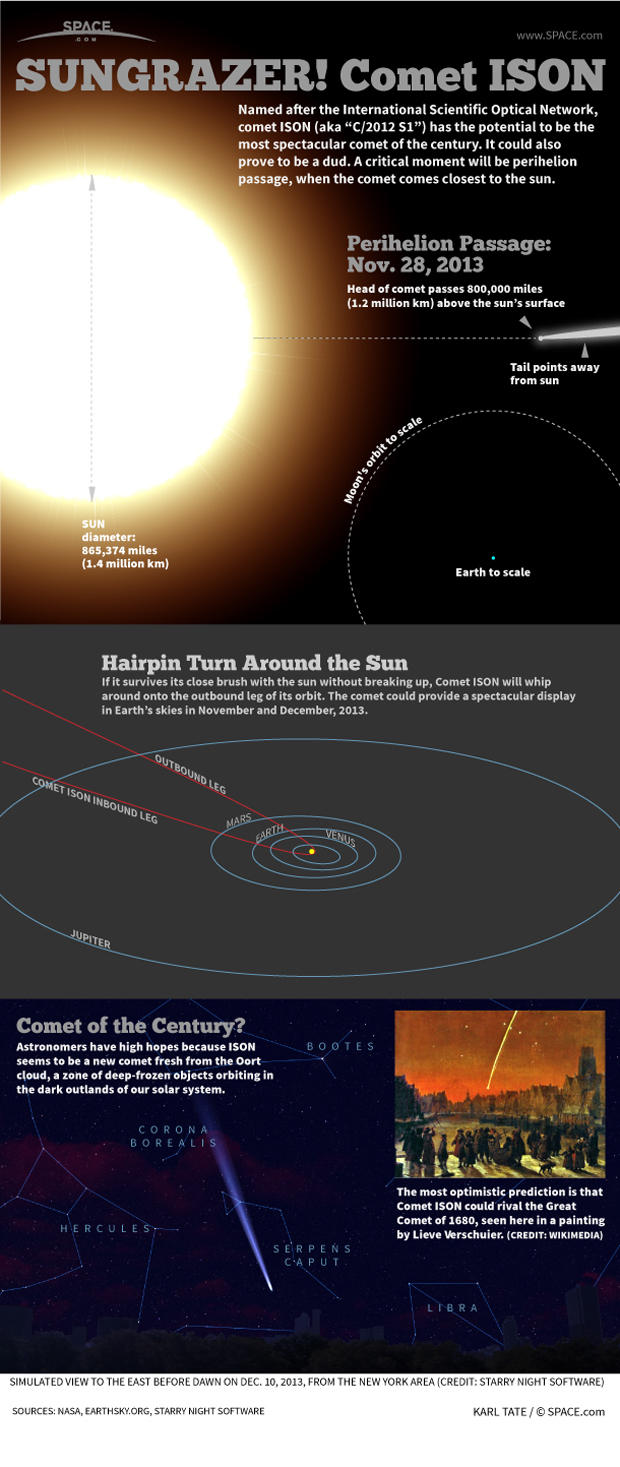Comet ISON Nears Sun for Thanksgiving Encounter in NASA Video

A NASA spacecraft has captured its best video yet of the icy Comet ISON streaking toward a Thanksgiving Day encounter with a sun, a close shave that the comet might just not survive.
The latest video of Comet ISON comes from NASA's STEREO-A spacecraft, one of several sun-watching space observatories tracking the comet's close encounter with the sun on Thursday (Nov. 28).
"This movie from the spacecraft's Heliospheric Imager shows Comet ISON, Mercury, Comet Encke and Earth over a five-day period from Nov. 20 to Nov. 25, 2013," NASA officials wrote in a video description. "The sun sits right of the field of view of this camera." [Comet ISON's Thanksgiving Sun Encounter: Complete Coverage]
Known officially as C/2012 S1 (ISON), Comet ISON is what scientists call a "sungrazer" comet because its orbit brings it extremely close to the sun. It is that extremely close solar shave, less than one diameter of the sun away, that has scientists guessing as to whether ISON will survive the encounter.
In the video, Comet ISON appears as a bright object streaking from left to right as it draws ever closer to the sun. Comet Encke, meanwhile, appears as a dimmer object moving from the upper left to lower right. The planets Mercury and Earth and labeled in the STEREO-A view.
NASA scientists, amateur astronomers and a fleet of spacecraft are tracking Comet ISON's solar passage on Thursday. The comet has drawn wide interest because of its potential to be a spectacular sight in the night sky, with some scientists dubbing the object a possible "comet of the century."
Comet ISON's origins in the distant Oort cloud, a realm of icy objects surrounding the entire solar system, has scientists excited because ISON is a pristine sample of the raw ingredients that formed Earth and other planets in the solar system.
Breaking space news, the latest updates on rocket launches, skywatching events and more!
Comet ISON was discovered in September 2012 by Russian amateur astronomers Vitali Nevski and Artyom Novichonok. Since then, it has been meticulously followed by professional and amateur astronomers using ground-based telescopes, as well as space-based observatories. The Hubble Space Telescope and NASA spacecraft orbiting Mars and Mercury have also captured images of the incoming comet.
On Thursday, NASA will hold a Google Hangout from 1 p.m. to 3:30 p.m. EST (1800 to 2030 GMT) to stream live views of the comet during its close sun approach. You will be able to watch the Comet ISON hangout live on SPACE.com here.
Editor's note: If you snap an amazing picture of Comet ISON or any other night sky view that you'd like to share for a possible story or image gallery, send photos, comments and your name and location to managing editor Tariq Malik at spacephotos@space.com.
You can follow the latest Comet ISON news, photos and video on SPACE.com.
Email Tariq Malik at tmalik@space.com or follow him @tariqjmalik and Google+. Follow us @Spacedotcom, Facebook and Google+. Original article on SPACE.com.

Tariq is the award-winning Editor-in-Chief of Space.com and joined the team in 2001. He covers human spaceflight, as well as skywatching and entertainment. He became Space.com's Editor-in-Chief in 2019. Before joining Space.com, Tariq was a staff reporter for The Los Angeles Times covering education and city beats in La Habra, Fullerton and Huntington Beach. He's a recipient of the 2022 Harry Kolcum Award for excellence in space reporting and the 2025 Space Pioneer Award from the National Space Society. He is an Eagle Scout and Space Camp alum with journalism degrees from the USC and NYU. You can find Tariq at Space.com and as the co-host to the This Week In Space podcast on the TWiT network. To see his latest project, you can follow Tariq on Twitter @tariqjmalik.


